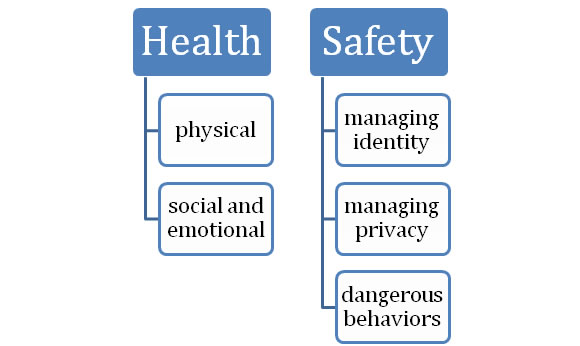

Health and Safety Guidelines
The Health and Safety Guidelines contain descriptors referring to attitudes and behaviors toward the healthy and safe use of technology. The guidelines are organized into subgroups under health and safety, as follows.

Physical Health:
- Students recognize possible health issues while using technology.
- Students take measures to prevent injuries while using technology.
Social and Emotional Health:
- Students establish an appropriate balance between time spent alone using technology; time spent interacting with family and friends, and time spent on personal well-being.
- Students consider the potential impact on self and others when viewing or sharing digital content.
- Students seek support for self and others when encountering conflict/bullying/abuse online (develop skills for conflict resolution, healthy communication, healthy relationships, knows who to talk to or where to find help).
- Students alert appropriate authorities regarding potential threats.
Safety – Managing Identity:
- Students understand that personal information shared online is public and, permanent, and has implications on how they are perceived by others (considers identity when posting photos, etc.).
- Students show respectful behavior when interacting with others online (use respectful behavior and language, considers feelings and reputation of others, etc.).
Safety – Managing Privacy:
- Students consider privacy of self and others when sharing personal information online (aware of danger of identity theft, etc.).
- Students alert the appropriate authorities regarding potential threats of privacy of self or others.
- Students read and consider the terms of service before joining online networks, downloading information, etc..
- Students consider the impact of sharing information (who will see the information, how will it be used, who will own the information, etc.).
- Students protect personal information (make use of security tools, privacy settings, password management, etc.).
Safety – Dangerous Behaviors:
- Students recognize the implications of being distracted while using technology (dangers of texting while. driving,implications of inattention when caring for children/others, importance of attentiveness to surroundings, etc.).
- Students think critically when communicating with others online (assess potential for cyber bullying, luring, threats to safety, etc.).
- Students recognize the consequences of engaging in risky or illegal behaviours (legal implications of sending explicit messages, accessing/distributing child pornography, luring, etc.).
- Students know how and where to seek support when a risk is identified.